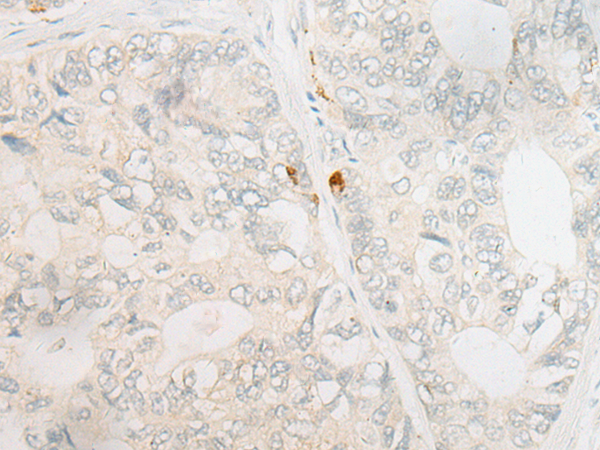
| WB | 1/500 - 1/2000 | Human,Mouse,Rabbit |
| IF | 咨询技术 | Human,Mouse,Rabbit |
| IHC | 1/100 - 1/500 | Human,Mouse,Rabbit |
| ICC | 1/50 - 1/500 | Human,Mouse,Rabbit |
| FCM | 1/200 - 1/400 | Human,Mouse,Rabbit |
| Elisa | 1/10000 | Human,Mouse,Rabbit |
| Aliases | CTF; ECO1; EFO1; ESO1; A930014I12Rik |
| Host/Isotype | Rabbit IgG |
| Antibody Type | Primary antibody |
| Storage | Store at 4°C short term. Aliquot and store at -20°C long term. Avoid freeze/thaw cycles. |
| Species Reactivity | Human |
| Immunogen | Synthetic peptide of human ESCO1 |
| Formulation | Purified antibody in PBS with 0.05% sodium azide and 50% glycerol. |
+ +
以下是关于p44/42 MAPK (Erk1/2)抗体的3篇代表性文献摘要:
---
1. **文献名称**:*The ERK1/2 mitogen-activated protein kinase pathway as a master regulator of the G1- to S-phase transition*
**作者**:Meloche, S., & Pouysségur, J. (2007)
**摘要**:该综述阐明了ERK1/2信号通路在细胞周期G1/S期转换中的核心作用,强调其通过磷酸化下游靶点(如转录因子和细胞周期调控蛋白)促进细胞增殖。研究中利用ERK1/2特异性抗体(如磷酸化抗体p-Erk1/2)验证了其在癌症模型中的激活状态。
---
2. **文献名称**:*Regulation and function of the RSK family of CREB kinases*
**作者**:Roux, P.P., et al. (2007)
**摘要**:本文研究了ERK1/2下游效应分子RSK激酶的功能,通过Western blot和免疫荧光技术(使用p44/42 MAPK抗体)证明ERK1/2激活后对RSK的磷酸化调控,及其在基因转录和细胞存活中的关键作用。
---
3. **文献名称**:*Targeting the Raf-MEK-ERK mitogen-activated protein kinase cascade for the treatment of cancer*
**作者**:Roberts, P.J., & Der, C.J. (2007)
**摘要**:该研究评估了靶向ERK1/2通路的抗癌策略,利用ERK1/2特异性抗体检测肿瘤组织中ERK磷酸化水平,证实其作为治疗响应生物标志物的潜力,并探讨了耐药机制中ERK重新激活的现象。
---
**备注**:以上文献均通过ERK1/2抗体(包括总蛋白及磷酸化形式)进行实验验证,涉及Western blot、免疫组化等技术,聚焦于信号通路机制、疾病关联及治疗应用。具体抗体品牌(如Cell Signaling Technology #9102)常在其方法部分注明。
The p44/42 mitogen-activated protein kinase (MAPK), also known as extracellular signal-regulated kinase 1/2 (Erk1/2), is a central signaling component involved in regulating cell proliferation, differentiation, survival, and apoptosis. These serine/threonine kinases are activated through a phosphorylation cascade triggered by extracellular stimuli such as growth factors, hormones, or stress. Erk1 (44 kDa) and Erk2 (42 kDa) share ~85% amino acid sequence identity and are ubiquitously expressed, though Erk2 is often more abundant. Their activation requires dual phosphorylation at conserved threonine and tyrosine residues (Thr202/Tyr204 in Erk1; Thr185/Tyr187 in Erk2), which induces conformational changes enabling substrate recognition and nuclear translocation.
Antibodies targeting p44/42 MAPK (Erk1/2) are essential tools for studying this pathway. They typically detect either total Erk1/2 (regardless of phosphorylation status) or specifically the activated, phosphorylated forms (p-Erk1/2). These antibodies are widely used in techniques like Western blotting, immunofluorescence, and immunohistochemistry to assess Erk1/2 expression, localization, and activation dynamics in response to stimuli or inhibitors. Researchers rely on them to explore roles in cancer (e.g., hyperactivation in tumors), developmental biology, and drug discovery. Validation of these antibodies often includes verifying specificity using knockout cells or phosphorylation-site mutants. Their application extends to both basic research and clinical studies, particularly in evaluating pathway activity in diseases or therapeutic responses.
×